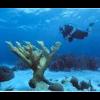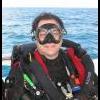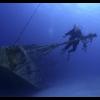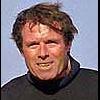
Steel Tanks
#31

Posted 20 May 2005 - 12:53 PM
Trust me anything new or different, shinny or requiring thought, can sometimes cause problems.
Keep it simple and uncomplicated. Make it 3rd grade understandable.
Inland you get a bunch of, "Gee boss let me try, I'd never tried to fix a transmisseon before." Be afraid be very afraid. :dltears:
#32

Posted 20 May 2005 - 07:45 PM
BTW, all of the E series cylinders from PST are 3442 psi service pressure.
--Vince Lombardi
#33

Posted 22 May 2005 - 01:26 PM
Checking the PST site, they apparently do certify the valve with either DIN or yoke. In that regard, I stand corrected. I changed my valves to 300 bar manifold valves when I got them. So, I didn't recall whether they came with 232 or 300 bar valves when I purchased them.The new E series PST cylinders came out so that people could use a yoke with them. It is safe to use yoke up to 3500 psi. Thats why the cylinders are rated to 3442. They come with a convertible 232 bar DIN/yoke valve. This valve is acceptable to the DOT for service to 3442 psi. Thats why they use them. Its perfectly OK, normal, and acceptable. If dive shops havent seen the E series cylinders yet, and dont know what the pressure is, and the fact that they use a yoke valve, then they need an education anyway...
BTW, all of the E series cylinders from PST are 3442 psi service pressure.
On the other hand, the last time I checked the relevant standards (and this was back in the late '90s), "With respect to yoke fittings, the CGA (USA) recommend[ed] maximum fill pressures of 200 bar and CEN (Europe) recommend[ed] DIN fittings for fill pressures over 234 bar." So, I guess that the 3442 pressure is right on the cusp.
Not exactly where I would choose to be if I had a choice. However, to each, his/her own degree of acceptable risk limits I guess.
"For the diligent diver, closed circuit rebreathers are actually safer than open circuit scuba." Tom Mount
#34

Posted 22 May 2005 - 04:14 PM
#35

Posted 22 May 2005 - 06:58 PM
Thanks for all the insight! I know I want PST 80's with the converible value. Now if they were only in stock in FLorida. Don't want to have to pay for the shipping.
They are available from Dive Rite Express, which is located in FL, at a reasonable price. You can purchase them as two single tanks or get a doubles package. If you want to double them, let me know as I recently did that and there are a couple tricks necessary due to the short length. Otherwise, they are a good choice.
#36

Posted 05 July 2005 - 10:45 PM
... On the other hand, the last time I checked the relevant standards (and this was back in the late '90s), "With respect to yoke fittings, the CGA (USA) recommend[ed] maximum fill pressures of 200 bar and CEN (Europe) recommend[ed] DIN fittings for fill pressures over 234 bar."Â So, I guess that the 3442 pressure is right on the cusp.
Not exactly where I would choose to be if I had a choice. However, to each, his/her own degree of acceptable risk limits I guess.
It may be on the cusp of the recommendation, but not on the cusp of the actual safety limit. Knowing that some yokels will probably push whatever limit is recommended, there's probably some safety limit already built into that recommendation. Unfortunately, the actual margin of safety already built-in is not detailed (which is common), so it's hard to know if, being reasonably risk-averse, adding an additional margin of safety is really effective or useless overkill. Of course, this is all conjecture on my part, IANAPTME (I Am Not A Pressurized Tank Manufacturing Engineer). Maybe at 3444 on a 234, those suckers blow!
Edited by leaudaustin, 06 July 2005 - 07:32 AM.
#37

Posted 06 July 2005 - 05:20 AM
Maybe at 3444 on a 234, those suckers blow!
No. I've seen yokes filled to 4000 PSI with no problems.
DSSW,
WWW
#38

Posted 06 July 2005 - 06:53 AM
I purchased some steel 119's , they are 8" tanks. Much shorter the the standard 120's and seem to do the job very well. They use a yoke connection, but I converted mine to din. They do however have a yoke adapter that you can use if you coverted to a din connection on your regulator!The new E series PST cylinders came out so that people could use a yoke with them. It is safe to use yoke up to 3500 psi. Thats why the cylinders are rated to 3442. They come with a convertible 232 bar DIN/yoke valve. This valve is acceptable to the DOT for service to 3442 psi. Thats why they use them. Its perfectly OK, normal, and acceptable. If dive shops havent seen the E series cylinders yet, and dont know what the pressure is, and the fact that they use a yoke valve, then they need an education anyway...
BTW, all of the E series cylinders from PST are 3442 psi service pressure.
Which end is up?
#39

Posted 16 August 2005 - 07:37 PM
Agree with Walter. I have several hundred tanks that attest to this.What problems? Most whips I see are yoke anyway and adapters are used to fill DIN tanks. Why would the tank monkey care if he attaches a yoke to an adapter or directly to the valve? While a DIN connection is more secure, the yoke connection works quite well at those pressures.
#40

Posted 16 August 2005 - 10:01 PM
Most come with a convertable valve. It'll usually work with DIN by removing the adapter and yoke by leaving it in.
Who's tanks? I know PST come std. with the DIN/Yoke valve.
If not I have a couple Yoke valves I'll trade ya' :-)
High pressure (3,500 psi) steel tanks do not generally offer the option of DIN/yoke. It is only the intermediate pressure steel tanks (3,442 psi and lower) that do. Not sure about low pressure steel tanks- I consider them water heaters.
I would not consider traveling with my tanks anywhere I can't drive (or boat). Of course I wish I could easily take my pony bottle, but in today's climate that is not possible.
Not all yoke regs can handle 3,500 psi pressures. Mine are rated at 3,000 psi. I don't use them on my high pressure tanks.
Edited by drbill, 16 August 2005 - 10:04 PM.
0 user(s) are reading this topic
0 members, 0 guests, 0 anonymous users




















